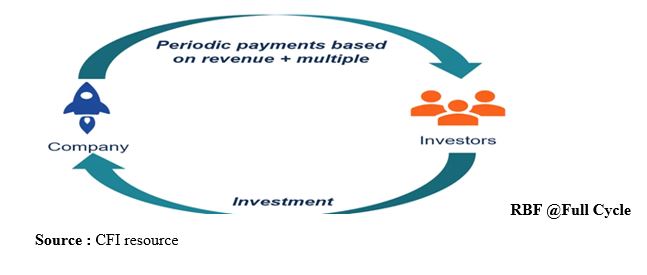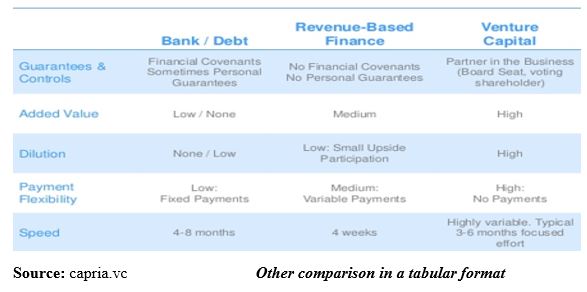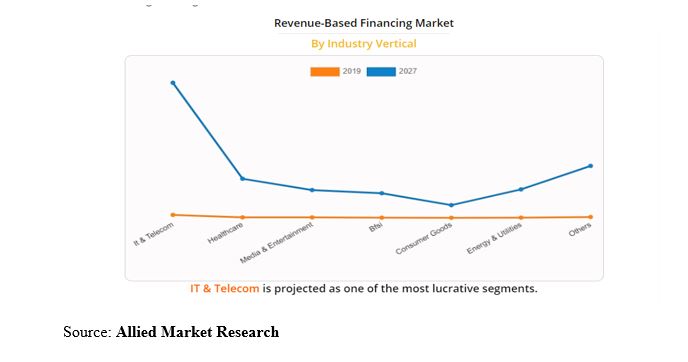“Banking gives you a glimpse into what makes companies succeed and what makes companies fail.”
———-Sarah Margaret “Sally” Roffey Jewell
Overview
Amongst the myriad of challenges faced by businesses from startup to the corporate levels, is the issue of financing. Ideally, opportunities for accessing capital abound from family, friends, angel investors, venture capitalists, bank loans, etc. but requirements have been the bane of businesses that get these countless opportunities. Venture capital for example is not always easy to come by and requires founders to give up their equity. At the same time, banks are stricter than ever in lending to small businesses. In this case, it is important to evaluate which funding mechanism should be chosen to avoid losses and also has the least rigorous requirements to access.
In recent years, revenue-based financing has caused a buzz in the start-up to corporate levels in the world and offers founders an alternative method of raising capital. But how does revenue-based financing work? To what extent does it differ from regular debt and equity financing? And how can banks connect the dots between revenue-based financing and sustainability?
Revenue-based Financing
Revenue-based financing (RBF) also known as Royalty-based financing is an innovative model that blends the features of debt & equity financing. This funding mechanism emerged in the early 1990s and was started by venture capitalist Arthur Fox, an engineer and later investor in 1992. Unlike a traditional funding method with a fixed repayment term and fixed interest rate, borrowers promise to pay a percentage of their future income (Wood. M., 2020). The debt is satisfied when the pre-defined absolute amount, the so-called repayment cap, is repaid. The repayment cap, set at the beginning of the loan, is usually 1.5 to 2.5 times the principal amount of the loan. The monthly repayment amount is linked to the company’s performance, which is why the monthly installments will fluctuate. In other words, the lower the revenue, the lesser the return and the higher the revenue, the higher the return (Chmyshuk. M., 2020).
In simple terms, a company receives capital investment in exchange for a share in its future revenue until a seeded absolute amount (the cap) is repaid. As the repayment ability is linked to the revenues that are generated, the investment can easily be escalated step-by-step as the borrower’s revenues grow over time. The capital the company receives is expected to be invested in the future growth of the business, e.g. through hiring additional employees, creating or scaling a product, or sales and marketing initiatives. The RBF provider will expect the company receiving investment to have a growth plan that reflects how the money will be spent and what the expected impact on growth will be.
Scenarios:
Eg.1: If you borrow Ghc30,000, your monthly turnover determines your loan term and your payments will align to an agreed percentage of your monthly sales. Therefore, if your turnover is Ghc60,000 for one month and you have agreed to repay 10% of your monthly sales each month, you would pay Ghc6,000. If it goes down to Ghc55,000, you pay Ghc5,500. This continues until the agreed amount is repaid.
Eg.2: A start-up business requires Ghc200,000 as capital and generates sales of Ghc50,000 per month. RBF lender has repayment cap of 1.3x, total payable for this borrowing will be Ghc230,000 If the monthly revenue percentage is set at say 5%, the average repayment will be 5% x Ghc50,000 thus Ghc2,500 per month. If sales remain at Ghc50,000 throughout the period, then you require about eight years to repay the amount borrowed. However, if sales change/fluctuate within the various months, the repayment duration will differ.

Revenue-Based Finance vs. Debt and Equity-based Financing
At first glance, revenue-based financing seems to be similar to debt financing since investors are entitled to regular repayments of their originally invested capital. However, there are numerous reasons, why RBF is an attractive alternative funding option for enterprises (Inc24, 2019). These include but not limited to:
- Less cumbersome nature: Traditional financing by banks requires
- tangible assets as collateral and this poses challenges particularly for tech-driven firms whose values are obtained from intangibles like intellectual property in software. This scenario does not apply to RBF and therefore makes it less cumbersome.
- Retaining ownership and control: Personal risks that come with RBF are reduced compared to the two more traditional financing options, by not requiring any personal guarantees or dilution of ownership and control.
- Flexible repayment and lower risks: The repayment terms of RBF are designed to be flexible for growing businesses with unforeseeable revenues. In other words, the monthly installments can be done fully out of cash flow.
- Common focus on growth: Since RBF involves a flexible repayment structure, investors’ returns increase as the startup grows faster. The outcome is that both, entrepreneur, and investor, have a common goal for the company, to increase revenue.
- Simple application process: Unlike the long and excessive amounts of information required with a traditional bank application, a revenue-based financing app is a simple one-page application. The only other documentation required is the company’s past 3 month’s bank and business services statements.

Target Group
SMEs without adequate security for traditional borrowing: These businesses may not meet requirements from traditional banks due to less or no tangible assets to represent as security for a loan facility.
Small businesses with large revenue streams: These businesses require capital injection to trigger higher volumes at very particular periods. Due to its quick nature of access, it becomes beneficial than the traditional system.
Businesses requiring upfront capital for greater market share: These like to reach new market frontiers without disrupting its ownership structure. This allows the company to focus on scaling operations without worrying about changes in equity.
Startups with direction for growth: With a clear path for growth and churning out revenues, the business does not need to meet criteria such as length of operation, before getting access to revenue-based funding from investors.
Some Revenue-based Financing Options
- GetVantage – https://getvantage.co
- Uplift 1 – https://www.uplift1.com
- Lighter Capital – https://www.lightercapital.com
- Round2 Capital Partners – https://www.round2cap.com
- Jenfi – https://jenfi.com
- Lend East – https://lendeast.com
- Klub – https://klubworks.com

Conclusion
Revenue-based financing is a great alternative for businesses to access funding to grow and expand. This presents another way for startups or SMEs and other businesses to make a case for investment.
Banks can leverage their business intelligence or research unit by creating an offshoot to strategically target businesses with reliable cash flow or straight path revenue growth to set up a revenue-based financing unit to cater for such. This presents a great opportunity to hit the bottom line. Though this initiative is gaining momentum and in Asia and the West currently, the African market with AfCFTA will soon take advantage to enable businesses in the value chain to enjoy great benefits.
References
Revenue-Based Financing: A Powerful Lending Option, Saratoga Investment Corp https://saratogainvestmentcorp.com/articles/revenue-based-financing/, accessed April 20, 2021
Revenue Based Financing: Investment Guide for Africa https://investmentguide.africa/funding/revenue-based-financing, accessed April 20, 2021
(USAID, 2017, p.12-36), Revenue Capital: A guide to the understanding, promotion, and implementation of revenue-based finance for fast-growth SMEs in the middle East and North Africa, https://www.marketlinks.org/sites/default/files/resource/files/508-Revenue-Captial-Guide-USAID-AMEG-2017-Final.pdf , accessed April 18, 2021
Inc24, (Oct. 15, 2019), Debt Funding Vs Equity Funding for Startups: Pros And Cons, https://inc42.com/fundraising-101/debt-funding-vs-equity-funding-for-startups-pros-and-cons/, accessed April 24, 2021
Singh, A., Revenue-Based Financing: An Alternative Funding Option, https://www.startupblog.com/revenue-based-financing-an-alternative-funding-option/, accessed April 24, 2021
Revenue-Based Financing, https://corporatefinanceinstitute.com/resources/knowledge/trading-investing/revenue-based-financing/ , accessed April 24, 2021
Luebbe, S., (Oct. 9, 2020), The Intersection of Angel Investors and Revenue-Based Financing, https://medium.com/startup-grind/the-intersection-of-angel-investors-and-revenue-based-financing-21a36b73913, accessed April 24, 2021
Round 2 Capital (Feb, 2020), Revenue Based Financing, https://www.round2cap.com/wp-content/uploads/2020/08/R2_Revenue_Based_Financing-2.pdf , accessed April 24, 2021
Flow Capital, (Sep. 16, 2019), Pros and Cons of Revenue-Based Financing, https://flowcap.com/pros-and-cons-revenue-based-financing/, accessed April 24, 2021
Chmyshuk. M. (2020), How Revenue-Based Financing Works: An introduction to revenue-based loans, https://fleximize.com/articles/000825/how-revenue-based-financing-works, accessed April 15, 2021
Wood. M, (Oct. 9, 2020), Revenue-Based Financing: Everything You Need to Know, https://www.fundera.com/business-loans/guides/revenue-based-financing#howitworks, accessed April 21, 2021
About the Writer:
Ebenezer ASUMANG, CGIA.MBA.MA(c) is a Development Communication Researcher, an SDG Market Building/Retail & SME nomad. He serves as Senior Project Manager with PIRON Global Development, Ghana.
Contact him via PIRON Global Development ( asumang@piron.global , www.piron.global)
Source: Ebenezer Asumang (Contributor)





